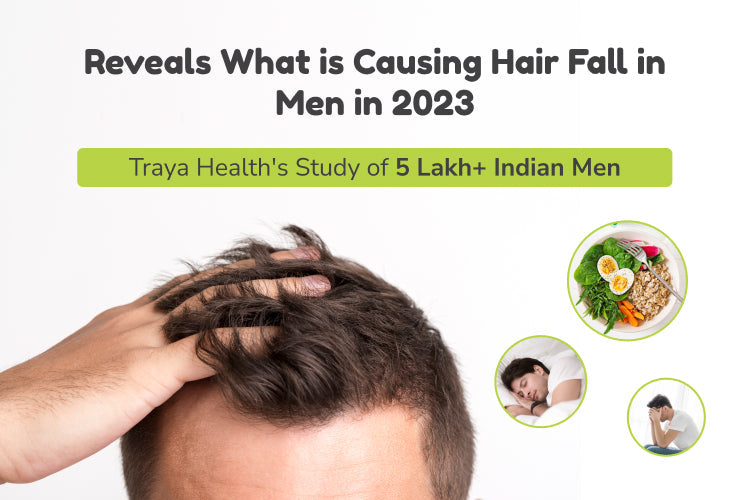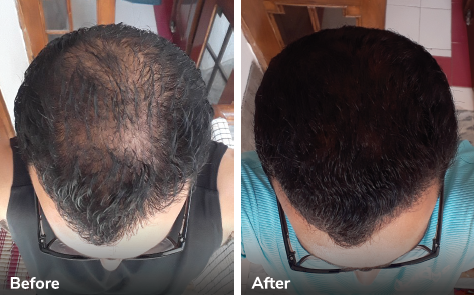Taking up a herculean task, Traya brings to everyone the hair loss statistics in India, from our hair test which had a whopping 5,36,622 participants. This extensive data of men across India has given us an unprecedented insight about the hair loss experienced by men.
Hair loss has become a rising concern in India, especially among men. However, balding in India is viewed as a cosmetic concern rather than a potential indicator for hidden health issues. Recognizing the need for a comprehensive study, Traya swept through the entire nation collecting data through a hair loss test. This initiative aimed to uncover and reveal the root causes for early hair loss and the need to raise awareness about it. Let us take a dive through Traya’s clinical study.
Hair test Questions:
These questions cover aspects such as hair quality, dandruff conditions, hair goals, family medical history, visual representations of their hair, any detected illnesses, fluctuations in weight, recent surgeries, heavy medication, daily energy levels, gut health, stress levels, sleep patterns, thyroid imbalances, blood pressure, and scalp conditions. It ends with asking for a photo to better diagnose your problem. The diagnosis and solution is tailored to each and every individual's specific condition accordingly.
This provides Traya with hair loss statistics about the Common Hair and Health Trends found in Indian Men. These “balding statistics” helps assign a hair stage for everyone, according to the Norwood stage:
-
Stage 1: No significant hair loss or recession. A mature hairline (normal adult hairline) may be present, but virtually no thinning.
-
Stage 2: Mild recession of the hairline around the temples (a slight “maturing” hairline). Some may call this a “widow’s peak.” There is still plenty of hair on top.
-
Stage 3: The first signs of visible balding. The hairline is noticeably deeper at the temples, often forming an M, U or V shape. Thinning may start at the crown as well.
-
Stage 3 Vertex (3V): The front hairline stays at a Stage 2 position, but significant hair loss appears at the vertex (crown). You see a bald spot on top while the front is still relatively full.
-
Stage 4: Hair loss is more severe. The temple recession is deeper, and the crown bald spot is larger, but a band of thicker hair still separates the two bald areas.
-
Stage 5: The bald areas at the temples and crown enlarge and the connecting band of hair narrows. On close inspection, these areas are bigger than in Stage 4.
-
Stage 6: The bridge of hair between the bald crown and the receded temples is gone. A single larger bald area spans the top of the head. Only hair on the sides and back remains.
-
Stage 7: The most severe form. Only a narrow band of hair runs around the sides and back of the head. This hair is often thin and fine. The scalp is almost entirely bald except for the horseshoe-shaped rim around the back.
Scale: Traya uses the Norwood Hair Loss Scale to identify the stage of hair loss in Men. Read more about this: https://pmc.ncbi.nlm.nih.gov/articles/PMC5596658/
Findings:
Our study pertaining to Indian Men has unveiled some important insights into Indian Hair Health.
-
Age:
Starting with the most startling discovery, 60% of the young men under 25 years of age are experiencing hair loss. This leads to an emphasis on the critical importance of stress management, particularly in this age group, to maintain healthy hair.
-
Sleep-Related Issues:
Sleep-related issues are also at its paramount, with approximately 30% of individuals under the age of 25 are experiencing hair loss due to irregular sleep patterns. This highlights the role of maintaining healthy sleep habits, especially for men in their early twenties.
-
Weight and Dieting:
We also found that 13% of young men under 25 are dealing with receding hairlines, while an equally concerning 13% are facing hair loss due to sudden changes in weight, such as extreme dieting or significant weight gain or loss. These hair loss statistics signify the importance of maintaining a balanced diet and healthy weight for good hair health.
-
Hair loss due to Dandruff:
Dandruff is another pressing issue, affecting a significant 65% of young Indian males under 25, with 38% experiencing severe cases. Addressing dandruff becomes of the highest care to prevent hair loss in this age bracket.
-
Poor Gut Health:
Additionally, our study also revealed that 37% (1,98,550 people) of all participants in this study attributed their hair loss to poor gut health. This suggests a strong connection between digestive well-being and hair condition, making holistic health crucial for young men's hair health.
-
Growing Awareness at a Young Age
On the flip side, we do see a growing awareness among men regarding hair fall. This consciousness is definitely promising to save the hair health of the future of India.
-
Lack of Early Action
However, it is also concerning that a significant proportion of the participants (aged 21-25) have already progressed to Stage 2 of the Norwood Hair Loss Scale due to a lack of treatment during Stage 1. This highlights the critical need for early intervention and taking action to improve hair health.
-
Genetics
Finally, genetics also plays a major role, with over 60% of men (under 25) believing that genetics significantly contributes to their hair loss. Understanding hereditary factors is crucial for these young individuals navigating their hair health journey.
In summary, the findings of our study tell us a story about the hair health challenges faced by young Indian men. These results highlight the importance of stress management, healthy sleeping habits, balanced diet, and addressing dandruff for maintaining hair health in this age group. Additionally, the need for holistic well-being, early awareness and action, and also understanding of genetics in the context of hair loss cannot be overstated.
Patterns & How can this data help you:
After analyzing the data from over 5,36,622 Indian men who took Traya’s Hair Test, clear trends emerged about early hair loss:
-
Hair loss begins much earlier than expected: A significant number of men started experiencing visible hair thinning as early as 21 years old,
-
Stage 2 hair loss is the most reported entry point: Many men are unable to realise their hair loss at Stage 1, which makes Stage 2 the common entry point for Hair fall related queries to begin.
-
Stress, Sleep, Stomach: 60% of young men reported stress-related hair loss, while 30% experienced hair fall due to poor sleep, and 37% linked it to gut health.
-
Dandruff is a silent contributor: 65% of men under 25 suffer from dandruff, while 38% facing severe cases, making it a major but often the most ignored cause of hair fall.
-
Weight Worries impact Hair Health: Extreme dieting, rapid weight gain, or sudden weight loss were reported as the key factor in almost 13% of cases.
-
Genetics vs lifestyle: The misconception persists – Over 60% of men under 25 believe hair loss is purely genetic, often overlooking multiple treatable root causes.
This is Real India-specific hair loss data that highlights multiple patterns. The study of such patterns makes it possible to alert and enlighten the Young Men of India.
Where Do You Stand on India’s Hair Loss Map?
Hair loss isn’t always just about genetics, it’s also about lifestyle, habits, and how early you take action. Here’s how different age groups typically experience hair fall and what approach works best:
|
Age Group |
Common Issues Observed |
Typical Stage |
Suggested Approach |
|
21–25 |
Stress, late nights, fast food, dandruff |
Stage 1 |
Early intervention can fully reverse hair loss. Focus on stress control, nutrition, and scalp health. |
|
26–30 |
Dandruff, early balding signs, poor gut health |
Stage 2–3 |
A multi-layered approach is needed, target root causes like digestion, hormones, and deficiencies. |
|
31–40 |
Hormonal imbalances, nutrient deficiencies, lifestyle stress |
Stage 3–4 |
Long-term consistency is key. Hair regrowth requires patience, internal balance, and sustained care. |
These classifications are taken broadly through the findings of the study, but one must note that any age group could deal with any stage of hairfall and to determine that, you could look at the norwood scale and for a better understanding take the hair test.
Stress Distribution by Region
In the statistical analysis conducted by Traya, stress was determined to be a leading factor in hair fall. The cortisol (stress hormone) dictates a large reason for hair fall in India. We have used the data to better understand the stress pattern in India, divided by region.
North India
High Stress States (Male): Delhi (7.3%), Uttar Pradesh (8.5%)
High Stress States (Female): Delhi (19.2%), Punjab (17.9%)
Low Stress Zones: Himachal Pradesh (29.3% of men, 21.9% of women reporting no stress)
Highlight: Chandigarh stands out with 22.6% of women reporting no stress
East India
High Stress States (Male): West Bengal (9.8%), Bihar (7.8%)
High Stress States (Female): West Bengal (22.3%), Jharkhand (18.2%)
Observation: Both genders in West Bengal show some of the highest stress percentages in India
Balanced Regions: Assam and Tripura show relatively lower stress in women
West India
Most Stressed State: Maharashtra
-
Men: 7.3% high stress
-
Women: 16.1% high stress
-
Low Stress Region: Goa, with a high percentage of users reporting no stress across both genders
South India
Urban Stress Zones: Hyderabad, Bengaluru, Chennai
-
Men: Hyderabad (9.8%), Bengaluru (7.7%)
-
Women: Hyderabad (19.8%), Bengaluru (18.6%)
Insight: Stress levels are similarly high for both men and women in southern metros, suggesting systemic urban stressors
Central India
Stress Trends: Madhya Pradesh and Chhattisgarh show lower high-stress levels and a dominance of moderate stress across both genders.
Notable Observation: Female stress levels in these states remain significantly lower than those seen in Tier-1 cities.
Regional breakdown of Sleep statistics
Part of the statistical analysis that Traya conducted was sleeping patterns. As discussed before, sleeping habits largely dictate the reaction to stress. With a good night’s sleep, the cortisol levels in the body reach an optimum level. Average percentage of men reporting peaceful sleep across regions:
|
Region |
Average Peaceful Sleep % |
|
North India |
69.7% |
|
Central India |
69.4% |
|
East India |
68.5% |
|
West India |
67.5% |
|
North-East India |
66.5% |
|
South India |
59.6% |
The most well-rested men in India live in Rajasthan (74%), Bihar (73%), and Uttarakhand (72%). In contrast, southern states like Andhra Pradesh (56%), Tamil Nadu (58%), and Telangana (60%) report significantly lower peaceful sleep scores.
Does Traya Work for Indian Men?
Hair loss is not the same for everybody, especially in India, where your diet, lifestyle, and genetics play a huge role. That’s why generic solutions tend to fail. Traya’s approach is holistic. It is designed specifically for Indian men’s unique hair loss patterns, ensuring personalized and effective results.
Traya believes in the three-fold way:
-
Ayurveda: Traya wholeheartedly believes that hair loss is reversed when your entire body cleanses itself. To aid in that, over half of the Traya products include Ayurvedic ingredients like Bhringraj, Ashwagandha and Sankpushpi.
-
Dermatology: To assist the Indian Homeopathic Nuske (prescriptions), we have multiple products that are approved by medical science. These include Minoxidil, Finasteride and Ketoconazole.
-
Nutrition: As aforementioned, Traya believes in a holistic approach. We also have a personal hair coach guiding you step by step in your diet.
Your hair loss has a reason. Traya finds it and fixes it the right way!
Real stories, Real Results:
"Traya’s Products helped me with reducing my hair fall in 6 months"
— Jayshree
Key Takeaway:
Conclusion:
With this study, Traya has managed to establish a framework where men can place themselves in an accurate age group and get a quick reality check about what fellow men are going through. Hair loss has become widespread and Traya believes that an internal cleansing alongside an external medication will help men relieve their glory days.
So what are you waiting for? Take the free 2 MIN HAIR TEST and diagnose the root cause for your hair fall.




